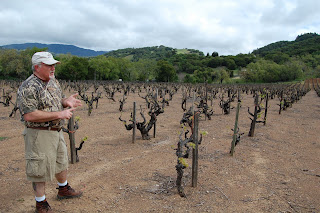
Castle Rock State Park is well-known to rock climbers and hikers who live in the Santa Clara Valley but, to most of us, it's one of a somewhat confusing string of parks and open space preserves with overwhelming hiking options along Skyline Boulevard (Highway 35) in the Santa Cruz Mountains. Last weekend, a friend and I headed up there on a sunny, warm Sunday morning. We walked the Saratoga Gap Trail, a lovely 5.2-mile loop (connect to the Ridge Trail on the return from the Castle Rock campground or it will be a 7-mile plus hike).
The ranger at the park entrance warned us it would be hot and it was, particularly on the hill-hugging exposed sections of the trail facing west, where there are some fine views of the Pacific ocean and the Santa Cruz Mountains. Most times of the year, a cool breeze would blow from the west but, on this day, the air was still and the sun scorching. There's no water along the trail, (except at the campground which is about half way along the route and one-tenth of a mile off the trail) so bring at least two quarts per person if you get a day such as this, when the temperatures reached the mid 80s. However, much of the trail is in lovely cool shade of redwoods, firs, oaks and madrones. We came across several kinds of wildflowers, including a meadow of lupine. Sandstone rock formations, hollowed from the wind, were awesome. The walk was a good work out with some steep spots and a little bit of scrambling up and down some rocky paths.
Back at the Castle Rock park entrance, we got in the car and drove north on Skyline Boulevard made a left on Alpine Road and slowly drove the green hills and hairpin turns, past cattle ranches and farms until we reached Highway 84 heading toward San Gregorio, a route which has to be the prettiest springtime drive in San Mateo County. The weather was spectacular, even at the coast. We poked around the old San Gregorio Store but had just missed the afternoon's live music. Continuing north to Half Moon Bay we stopped at the Flying Fish Grill, where the halibut fish and chips and the fish tacos are quite good and the friendly service and bright tropical setting make a fun stop for a quick bite.
I kicked myself for forgetting my camera on such a gorgeous day, but above is my favorite photo of Half Moon Bay and environs: a crab fisherman at the Princeton harbor.




